Analyzing Project Sustainability Management and Project Success
VerifiedAdded on 2020/11/09
|21
|5982
|114
Report
AI Summary
This report investigates the crucial relationship between project sustainability management (PSM) and project success (PS) within the textile industry, particularly in the context of Pakistan. The study addresses the limited literature available on PSM, especially in the textile sector, where sustainability is often a non-practical concept. It explores the impact of PSM on project success, considering environmental and social performance as mediating factors, and aims to provide recommendations for policy makers to promote export-driven industrialization and reduce trade deficits. The research adapts a model to analyze the interplay between product and project perspectives, focusing on aspects like design for environment, green procurement, and social responsibility. The study employs a quantitative approach, analyzing data from over 100 export orders to validate the hypothesized model. The report reviews existing literature, identifies research questions and objectives, and outlines the study's methodology and structure, including an overview of the literature review, research methodology, findings, and conclusions. The research highlights the significance of addressing sustainability concerns in project management and the need for empirical evidence to bridge the gap between PSM and PS, offering valuable insights for both academics and practitioners.
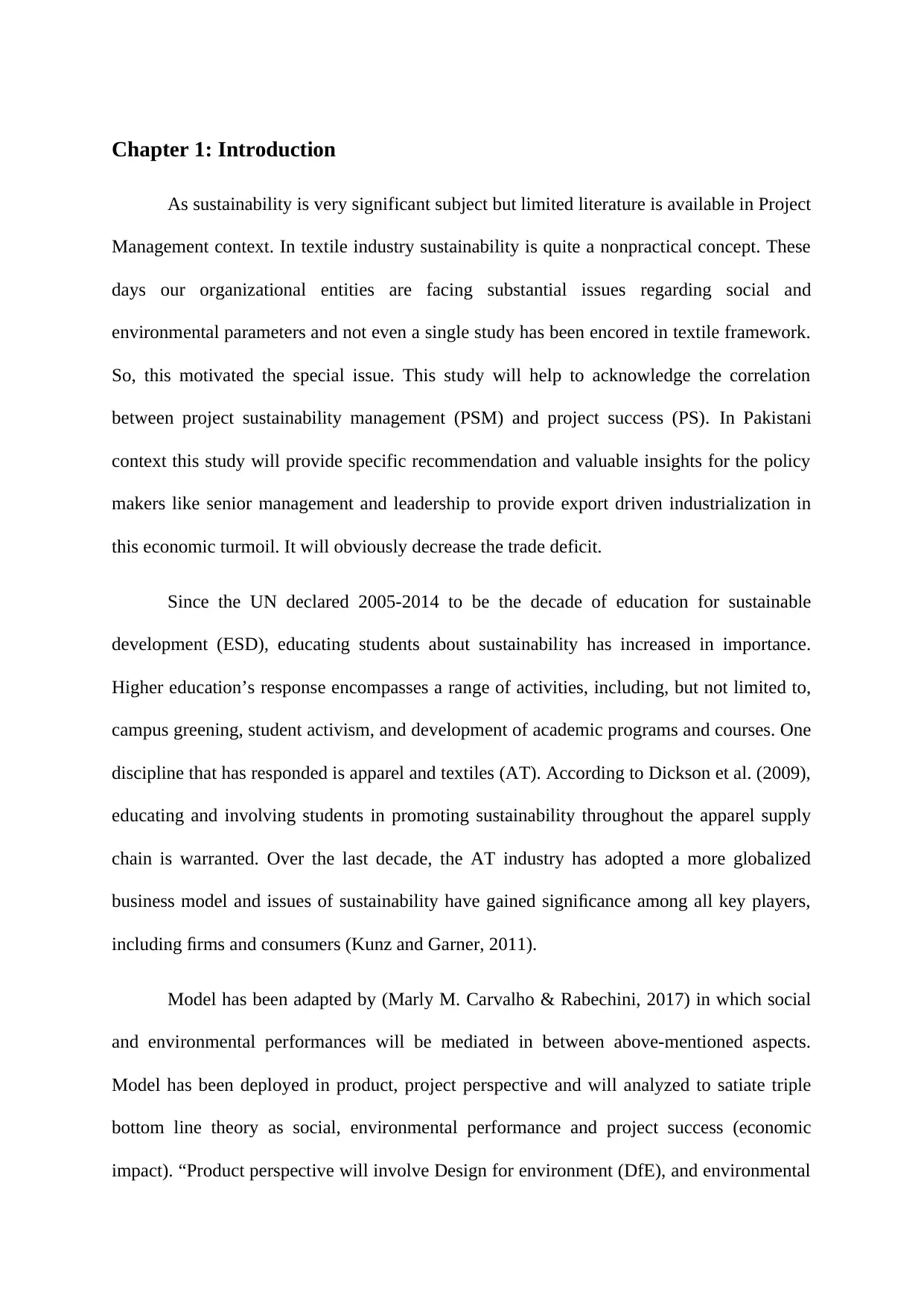
Chapter 1: Introduction
As sustainability is very significant subject but limited literature is available in Project
Management context. In textile industry sustainability is quite a nonpractical concept. These
days our organizational entities are facing substantial issues regarding social and
environmental parameters and not even a single study has been encored in textile framework.
So, this motivated the special issue. This study will help to acknowledge the correlation
between project sustainability management (PSM) and project success (PS). In Pakistani
context this study will provide specific recommendation and valuable insights for the policy
makers like senior management and leadership to provide export driven industrialization in
this economic turmoil. It will obviously decrease the trade deficit.
Since the UN declared 2005-2014 to be the decade of education for sustainable
development (ESD), educating students about sustainability has increased in importance.
Higher education’s response encompasses a range of activities, including, but not limited to,
campus greening, student activism, and development of academic programs and courses. One
discipline that has responded is apparel and textiles (AT). According to Dickson et al. (2009),
educating and involving students in promoting sustainability throughout the apparel supply
chain is warranted. Over the last decade, the AT industry has adopted a more globalized
business model and issues of sustainability have gained significance among all key players,
including firms and consumers (Kunz and Garner, 2011).
Model has been adapted by (Marly M. Carvalho & Rabechini, 2017) in which social
and environmental performances will be mediated in between above-mentioned aspects.
Model has been deployed in product, project perspective and will analyzed to satiate triple
bottom line theory as social, environmental performance and project success (economic
impact). “Product perspective will involve Design for environment (DfE), and environmental
As sustainability is very significant subject but limited literature is available in Project
Management context. In textile industry sustainability is quite a nonpractical concept. These
days our organizational entities are facing substantial issues regarding social and
environmental parameters and not even a single study has been encored in textile framework.
So, this motivated the special issue. This study will help to acknowledge the correlation
between project sustainability management (PSM) and project success (PS). In Pakistani
context this study will provide specific recommendation and valuable insights for the policy
makers like senior management and leadership to provide export driven industrialization in
this economic turmoil. It will obviously decrease the trade deficit.
Since the UN declared 2005-2014 to be the decade of education for sustainable
development (ESD), educating students about sustainability has increased in importance.
Higher education’s response encompasses a range of activities, including, but not limited to,
campus greening, student activism, and development of academic programs and courses. One
discipline that has responded is apparel and textiles (AT). According to Dickson et al. (2009),
educating and involving students in promoting sustainability throughout the apparel supply
chain is warranted. Over the last decade, the AT industry has adopted a more globalized
business model and issues of sustainability have gained significance among all key players,
including firms and consumers (Kunz and Garner, 2011).
Model has been adapted by (Marly M. Carvalho & Rabechini, 2017) in which social
and environmental performances will be mediated in between above-mentioned aspects.
Model has been deployed in product, project perspective and will analyzed to satiate triple
bottom line theory as social, environmental performance and project success (economic
impact). “Product perspective will involve Design for environment (DfE), and environmental
Paraphrase This Document
Need a fresh take? Get an instant paraphrase of this document with our AI Paraphraser
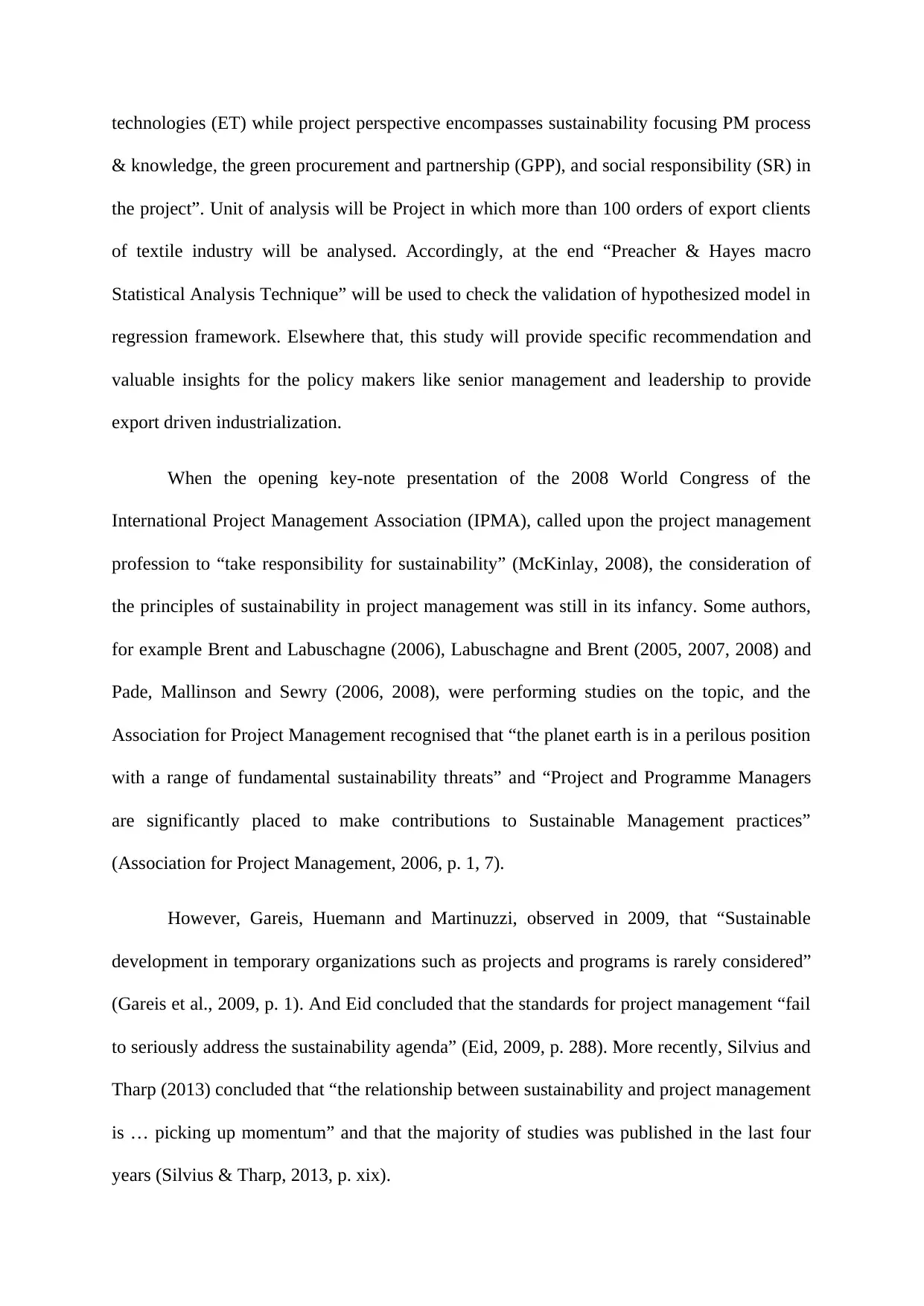
technologies (ET) while project perspective encompasses sustainability focusing PM process
& knowledge, the green procurement and partnership (GPP), and social responsibility (SR) in
the project”. Unit of analysis will be Project in which more than 100 orders of export clients
of textile industry will be analysed. Accordingly, at the end “Preacher & Hayes macro
Statistical Analysis Technique” will be used to check the validation of hypothesized model in
regression framework. Elsewhere that, this study will provide specific recommendation and
valuable insights for the policy makers like senior management and leadership to provide
export driven industrialization.
When the opening key-note presentation of the 2008 World Congress of the
International Project Management Association (IPMA), called upon the project management
profession to “take responsibility for sustainability” (McKinlay, 2008), the consideration of
the principles of sustainability in project management was still in its infancy. Some authors,
for example Brent and Labuschagne (2006), Labuschagne and Brent (2005, 2007, 2008) and
Pade, Mallinson and Sewry (2006, 2008), were performing studies on the topic, and the
Association for Project Management recognised that “the planet earth is in a perilous position
with a range of fundamental sustainability threats” and “Project and Programme Managers
are significantly placed to make contributions to Sustainable Management practices”
(Association for Project Management, 2006, p. 1, 7).
However, Gareis, Huemann and Martinuzzi, observed in 2009, that “Sustainable
development in temporary organizations such as projects and programs is rarely considered”
(Gareis et al., 2009, p. 1). And Eid concluded that the standards for project management “fail
to seriously address the sustainability agenda” (Eid, 2009, p. 288). More recently, Silvius and
Tharp (2013) concluded that “the relationship between sustainability and project management
is … picking up momentum” and that the majority of studies was published in the last four
years (Silvius & Tharp, 2013, p. xix).
& knowledge, the green procurement and partnership (GPP), and social responsibility (SR) in
the project”. Unit of analysis will be Project in which more than 100 orders of export clients
of textile industry will be analysed. Accordingly, at the end “Preacher & Hayes macro
Statistical Analysis Technique” will be used to check the validation of hypothesized model in
regression framework. Elsewhere that, this study will provide specific recommendation and
valuable insights for the policy makers like senior management and leadership to provide
export driven industrialization.
When the opening key-note presentation of the 2008 World Congress of the
International Project Management Association (IPMA), called upon the project management
profession to “take responsibility for sustainability” (McKinlay, 2008), the consideration of
the principles of sustainability in project management was still in its infancy. Some authors,
for example Brent and Labuschagne (2006), Labuschagne and Brent (2005, 2007, 2008) and
Pade, Mallinson and Sewry (2006, 2008), were performing studies on the topic, and the
Association for Project Management recognised that “the planet earth is in a perilous position
with a range of fundamental sustainability threats” and “Project and Programme Managers
are significantly placed to make contributions to Sustainable Management practices”
(Association for Project Management, 2006, p. 1, 7).
However, Gareis, Huemann and Martinuzzi, observed in 2009, that “Sustainable
development in temporary organizations such as projects and programs is rarely considered”
(Gareis et al., 2009, p. 1). And Eid concluded that the standards for project management “fail
to seriously address the sustainability agenda” (Eid, 2009, p. 288). More recently, Silvius and
Tharp (2013) concluded that “the relationship between sustainability and project management
is … picking up momentum” and that the majority of studies was published in the last four
years (Silvius & Tharp, 2013, p. xix).
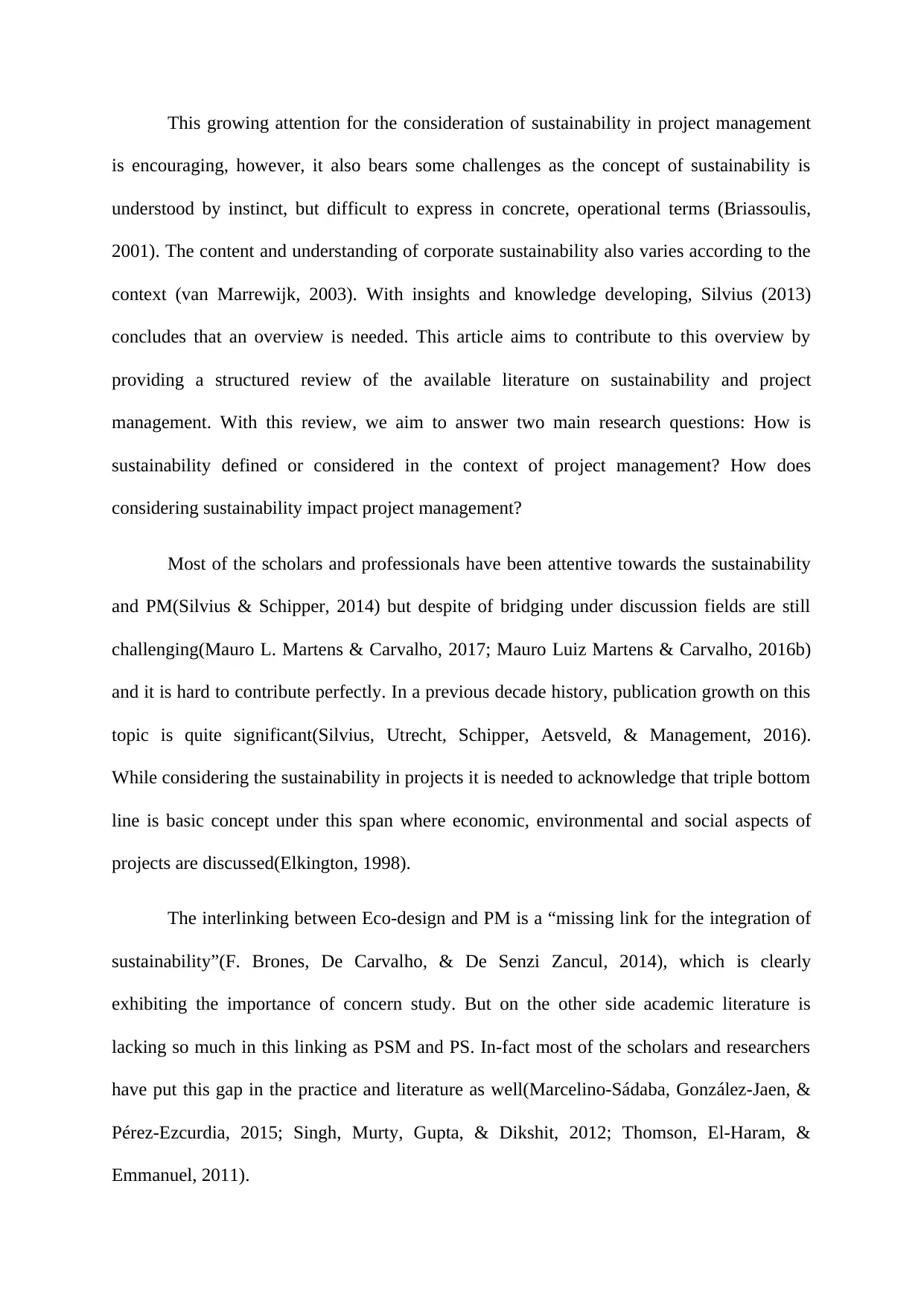
This growing attention for the consideration of sustainability in project management
is encouraging, however, it also bears some challenges as the concept of sustainability is
understood by instinct, but difficult to express in concrete, operational terms (Briassoulis,
2001). The content and understanding of corporate sustainability also varies according to the
context (van Marrewijk, 2003). With insights and knowledge developing, Silvius (2013)
concludes that an overview is needed. This article aims to contribute to this overview by
providing a structured review of the available literature on sustainability and project
management. With this review, we aim to answer two main research questions: How is
sustainability defined or considered in the context of project management? How does
considering sustainability impact project management?
Most of the scholars and professionals have been attentive towards the sustainability
and PM(Silvius & Schipper, 2014) but despite of bridging under discussion fields are still
challenging(Mauro L. Martens & Carvalho, 2017; Mauro Luiz Martens & Carvalho, 2016b)
and it is hard to contribute perfectly. In a previous decade history, publication growth on this
topic is quite significant(Silvius, Utrecht, Schipper, Aetsveld, & Management, 2016).
While considering the sustainability in projects it is needed to acknowledge that triple bottom
line is basic concept under this span where economic, environmental and social aspects of
projects are discussed(Elkington, 1998).
The interlinking between Eco-design and PM is a “missing link for the integration of
sustainability”(F. Brones, De Carvalho, & De Senzi Zancul, 2014), which is clearly
exhibiting the importance of concern study. But on the other side academic literature is
lacking so much in this linking as PSM and PS. In-fact most of the scholars and researchers
have put this gap in the practice and literature as well(Marcelino-Sádaba, González-Jaen, &
Pérez-Ezcurdia, 2015; Singh, Murty, Gupta, & Dikshit, 2012; Thomson, El-Haram, &
Emmanuel, 2011).
is encouraging, however, it also bears some challenges as the concept of sustainability is
understood by instinct, but difficult to express in concrete, operational terms (Briassoulis,
2001). The content and understanding of corporate sustainability also varies according to the
context (van Marrewijk, 2003). With insights and knowledge developing, Silvius (2013)
concludes that an overview is needed. This article aims to contribute to this overview by
providing a structured review of the available literature on sustainability and project
management. With this review, we aim to answer two main research questions: How is
sustainability defined or considered in the context of project management? How does
considering sustainability impact project management?
Most of the scholars and professionals have been attentive towards the sustainability
and PM(Silvius & Schipper, 2014) but despite of bridging under discussion fields are still
challenging(Mauro L. Martens & Carvalho, 2017; Mauro Luiz Martens & Carvalho, 2016b)
and it is hard to contribute perfectly. In a previous decade history, publication growth on this
topic is quite significant(Silvius, Utrecht, Schipper, Aetsveld, & Management, 2016).
While considering the sustainability in projects it is needed to acknowledge that triple bottom
line is basic concept under this span where economic, environmental and social aspects of
projects are discussed(Elkington, 1998).
The interlinking between Eco-design and PM is a “missing link for the integration of
sustainability”(F. Brones, De Carvalho, & De Senzi Zancul, 2014), which is clearly
exhibiting the importance of concern study. But on the other side academic literature is
lacking so much in this linking as PSM and PS. In-fact most of the scholars and researchers
have put this gap in the practice and literature as well(Marcelino-Sádaba, González-Jaen, &
Pérez-Ezcurdia, 2015; Singh, Murty, Gupta, & Dikshit, 2012; Thomson, El-Haram, &
Emmanuel, 2011).
⊘ This is a preview!⊘
Do you want full access?
Subscribe today to unlock all pages.

Trusted by 1+ million students worldwide
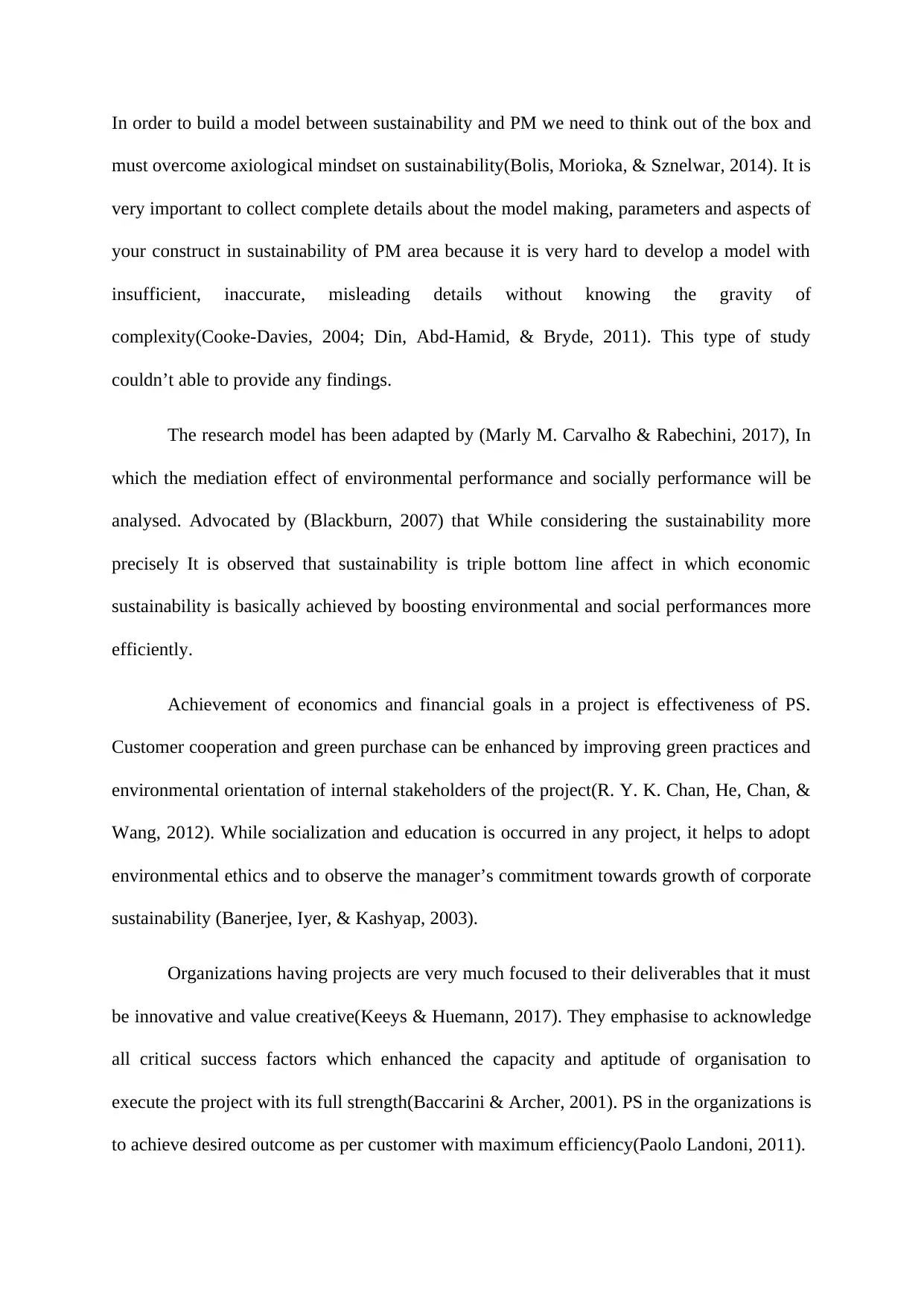
In order to build a model between sustainability and PM we need to think out of the box and
must overcome axiological mindset on sustainability(Bolis, Morioka, & Sznelwar, 2014). It is
very important to collect complete details about the model making, parameters and aspects of
your construct in sustainability of PM area because it is very hard to develop a model with
insufficient, inaccurate, misleading details without knowing the gravity of
complexity(Cooke-Davies, 2004; Din, Abd-Hamid, & Bryde, 2011). This type of study
couldn’t able to provide any findings.
The research model has been adapted by (Marly M. Carvalho & Rabechini, 2017), In
which the mediation effect of environmental performance and socially performance will be
analysed. Advocated by (Blackburn, 2007) that While considering the sustainability more
precisely It is observed that sustainability is triple bottom line affect in which economic
sustainability is basically achieved by boosting environmental and social performances more
efficiently.
Achievement of economics and financial goals in a project is effectiveness of PS.
Customer cooperation and green purchase can be enhanced by improving green practices and
environmental orientation of internal stakeholders of the project(R. Y. K. Chan, He, Chan, &
Wang, 2012). While socialization and education is occurred in any project, it helps to adopt
environmental ethics and to observe the manager’s commitment towards growth of corporate
sustainability (Banerjee, Iyer, & Kashyap, 2003).
Organizations having projects are very much focused to their deliverables that it must
be innovative and value creative(Keeys & Huemann, 2017). They emphasise to acknowledge
all critical success factors which enhanced the capacity and aptitude of organisation to
execute the project with its full strength(Baccarini & Archer, 2001). PS in the organizations is
to achieve desired outcome as per customer with maximum efficiency(Paolo Landoni, 2011).
must overcome axiological mindset on sustainability(Bolis, Morioka, & Sznelwar, 2014). It is
very important to collect complete details about the model making, parameters and aspects of
your construct in sustainability of PM area because it is very hard to develop a model with
insufficient, inaccurate, misleading details without knowing the gravity of
complexity(Cooke-Davies, 2004; Din, Abd-Hamid, & Bryde, 2011). This type of study
couldn’t able to provide any findings.
The research model has been adapted by (Marly M. Carvalho & Rabechini, 2017), In
which the mediation effect of environmental performance and socially performance will be
analysed. Advocated by (Blackburn, 2007) that While considering the sustainability more
precisely It is observed that sustainability is triple bottom line affect in which economic
sustainability is basically achieved by boosting environmental and social performances more
efficiently.
Achievement of economics and financial goals in a project is effectiveness of PS.
Customer cooperation and green purchase can be enhanced by improving green practices and
environmental orientation of internal stakeholders of the project(R. Y. K. Chan, He, Chan, &
Wang, 2012). While socialization and education is occurred in any project, it helps to adopt
environmental ethics and to observe the manager’s commitment towards growth of corporate
sustainability (Banerjee, Iyer, & Kashyap, 2003).
Organizations having projects are very much focused to their deliverables that it must
be innovative and value creative(Keeys & Huemann, 2017). They emphasise to acknowledge
all critical success factors which enhanced the capacity and aptitude of organisation to
execute the project with its full strength(Baccarini & Archer, 2001). PS in the organizations is
to achieve desired outcome as per customer with maximum efficiency(Paolo Landoni, 2011).
Paraphrase This Document
Need a fresh take? Get an instant paraphrase of this document with our AI Paraphraser
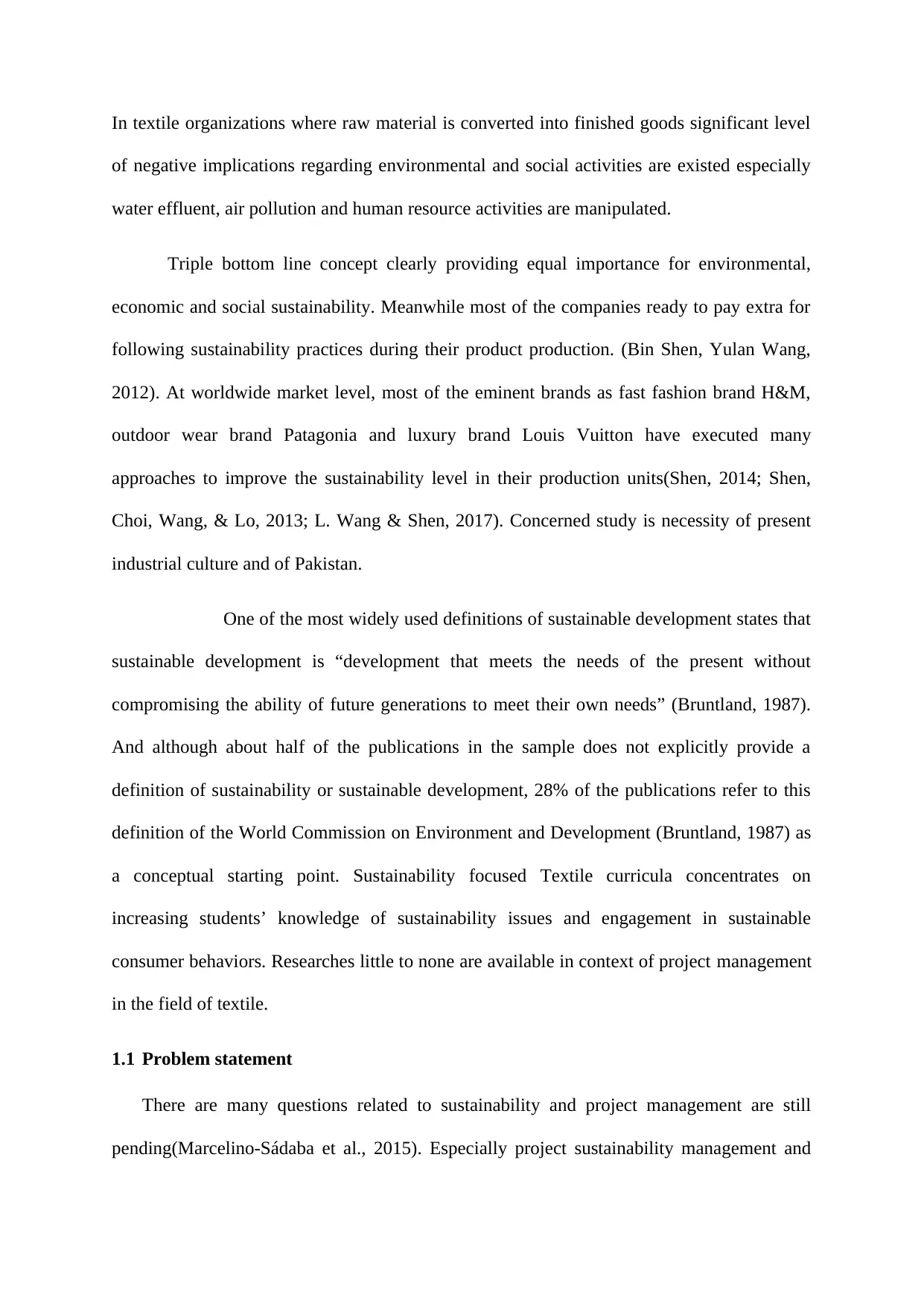
In textile organizations where raw material is converted into finished goods significant level
of negative implications regarding environmental and social activities are existed especially
water effluent, air pollution and human resource activities are manipulated.
Triple bottom line concept clearly providing equal importance for environmental,
economic and social sustainability. Meanwhile most of the companies ready to pay extra for
following sustainability practices during their product production. (Bin Shen, Yulan Wang,
2012). At worldwide market level, most of the eminent brands as fast fashion brand H&M,
outdoor wear brand Patagonia and luxury brand Louis Vuitton have executed many
approaches to improve the sustainability level in their production units(Shen, 2014; Shen,
Choi, Wang, & Lo, 2013; L. Wang & Shen, 2017). Concerned study is necessity of present
industrial culture and of Pakistan.
One of the most widely used definitions of sustainable development states that
sustainable development is “development that meets the needs of the present without
compromising the ability of future generations to meet their own needs” (Bruntland, 1987).
And although about half of the publications in the sample does not explicitly provide a
definition of sustainability or sustainable development, 28% of the publications refer to this
definition of the World Commission on Environment and Development (Bruntland, 1987) as
a conceptual starting point. Sustainability focused Textile curricula concentrates on
increasing students’ knowledge of sustainability issues and engagement in sustainable
consumer behaviors. Researches little to none are available in context of project management
in the field of textile.
1.1 Problem statement
There are many questions related to sustainability and project management are still
pending(Marcelino-Sádaba et al., 2015). Especially project sustainability management and
of negative implications regarding environmental and social activities are existed especially
water effluent, air pollution and human resource activities are manipulated.
Triple bottom line concept clearly providing equal importance for environmental,
economic and social sustainability. Meanwhile most of the companies ready to pay extra for
following sustainability practices during their product production. (Bin Shen, Yulan Wang,
2012). At worldwide market level, most of the eminent brands as fast fashion brand H&M,
outdoor wear brand Patagonia and luxury brand Louis Vuitton have executed many
approaches to improve the sustainability level in their production units(Shen, 2014; Shen,
Choi, Wang, & Lo, 2013; L. Wang & Shen, 2017). Concerned study is necessity of present
industrial culture and of Pakistan.
One of the most widely used definitions of sustainable development states that
sustainable development is “development that meets the needs of the present without
compromising the ability of future generations to meet their own needs” (Bruntland, 1987).
And although about half of the publications in the sample does not explicitly provide a
definition of sustainability or sustainable development, 28% of the publications refer to this
definition of the World Commission on Environment and Development (Bruntland, 1987) as
a conceptual starting point. Sustainability focused Textile curricula concentrates on
increasing students’ knowledge of sustainability issues and engagement in sustainable
consumer behaviors. Researches little to none are available in context of project management
in the field of textile.
1.1 Problem statement
There are many questions related to sustainability and project management are still
pending(Marcelino-Sádaba et al., 2015). Especially project sustainability management and
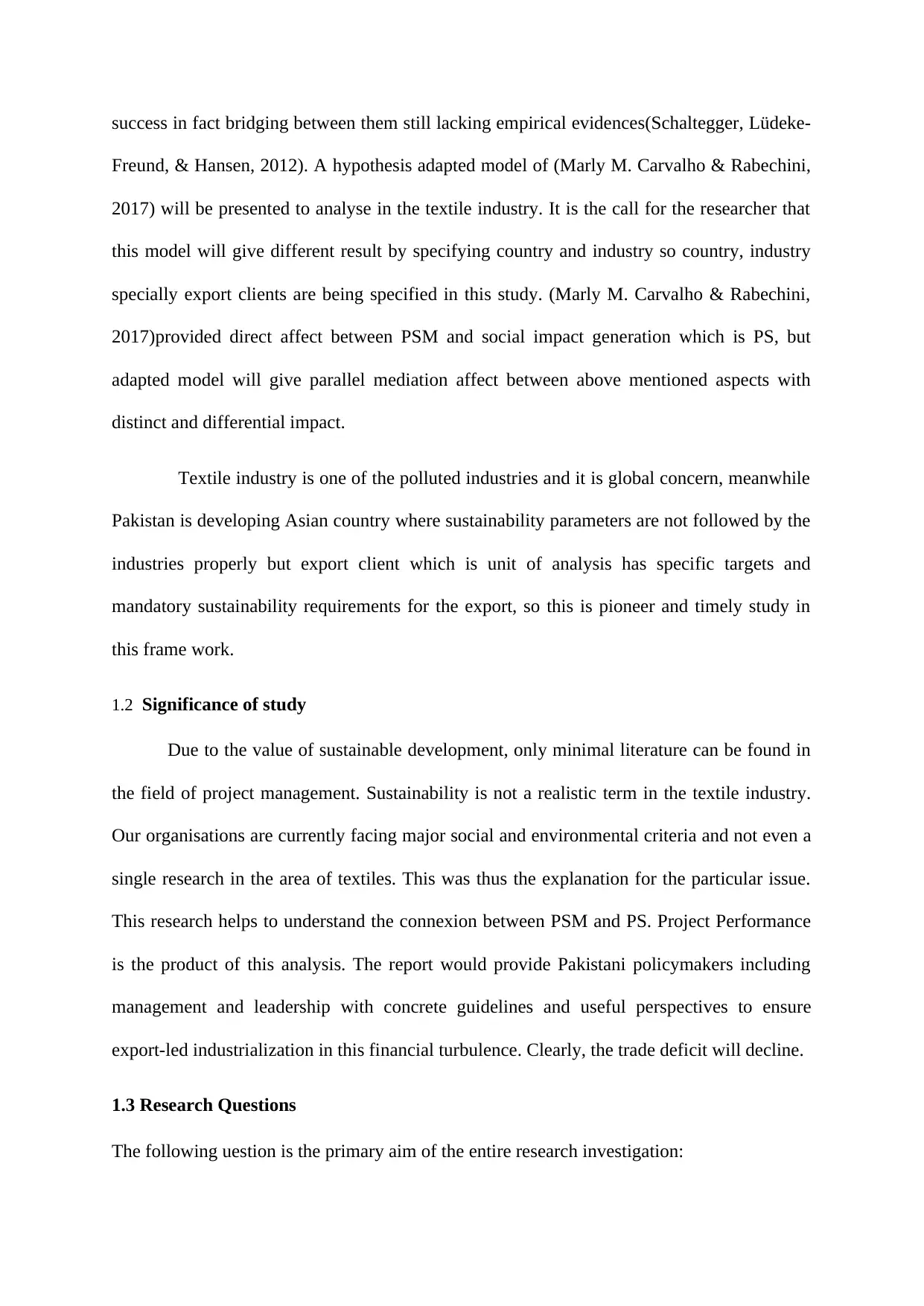
success in fact bridging between them still lacking empirical evidences(Schaltegger, Lüdeke-
Freund, & Hansen, 2012). A hypothesis adapted model of (Marly M. Carvalho & Rabechini,
2017) will be presented to analyse in the textile industry. It is the call for the researcher that
this model will give different result by specifying country and industry so country, industry
specially export clients are being specified in this study. (Marly M. Carvalho & Rabechini,
2017)provided direct affect between PSM and social impact generation which is PS, but
adapted model will give parallel mediation affect between above mentioned aspects with
distinct and differential impact.
Textile industry is one of the polluted industries and it is global concern, meanwhile
Pakistan is developing Asian country where sustainability parameters are not followed by the
industries properly but export client which is unit of analysis has specific targets and
mandatory sustainability requirements for the export, so this is pioneer and timely study in
this frame work.
1.2 Significance of study
Due to the value of sustainable development, only minimal literature can be found in
the field of project management. Sustainability is not a realistic term in the textile industry.
Our organisations are currently facing major social and environmental criteria and not even a
single research in the area of textiles. This was thus the explanation for the particular issue.
This research helps to understand the connexion between PSM and PS. Project Performance
is the product of this analysis. The report would provide Pakistani policymakers including
management and leadership with concrete guidelines and useful perspectives to ensure
export-led industrialization in this financial turbulence. Clearly, the trade deficit will decline.
1.3 Research Questions
The following uestion is the primary aim of the entire research investigation:
Freund, & Hansen, 2012). A hypothesis adapted model of (Marly M. Carvalho & Rabechini,
2017) will be presented to analyse in the textile industry. It is the call for the researcher that
this model will give different result by specifying country and industry so country, industry
specially export clients are being specified in this study. (Marly M. Carvalho & Rabechini,
2017)provided direct affect between PSM and social impact generation which is PS, but
adapted model will give parallel mediation affect between above mentioned aspects with
distinct and differential impact.
Textile industry is one of the polluted industries and it is global concern, meanwhile
Pakistan is developing Asian country where sustainability parameters are not followed by the
industries properly but export client which is unit of analysis has specific targets and
mandatory sustainability requirements for the export, so this is pioneer and timely study in
this frame work.
1.2 Significance of study
Due to the value of sustainable development, only minimal literature can be found in
the field of project management. Sustainability is not a realistic term in the textile industry.
Our organisations are currently facing major social and environmental criteria and not even a
single research in the area of textiles. This was thus the explanation for the particular issue.
This research helps to understand the connexion between PSM and PS. Project Performance
is the product of this analysis. The report would provide Pakistani policymakers including
management and leadership with concrete guidelines and useful perspectives to ensure
export-led industrialization in this financial turbulence. Clearly, the trade deficit will decline.
1.3 Research Questions
The following uestion is the primary aim of the entire research investigation:
⊘ This is a preview!⊘
Do you want full access?
Subscribe today to unlock all pages.

Trusted by 1+ million students worldwide
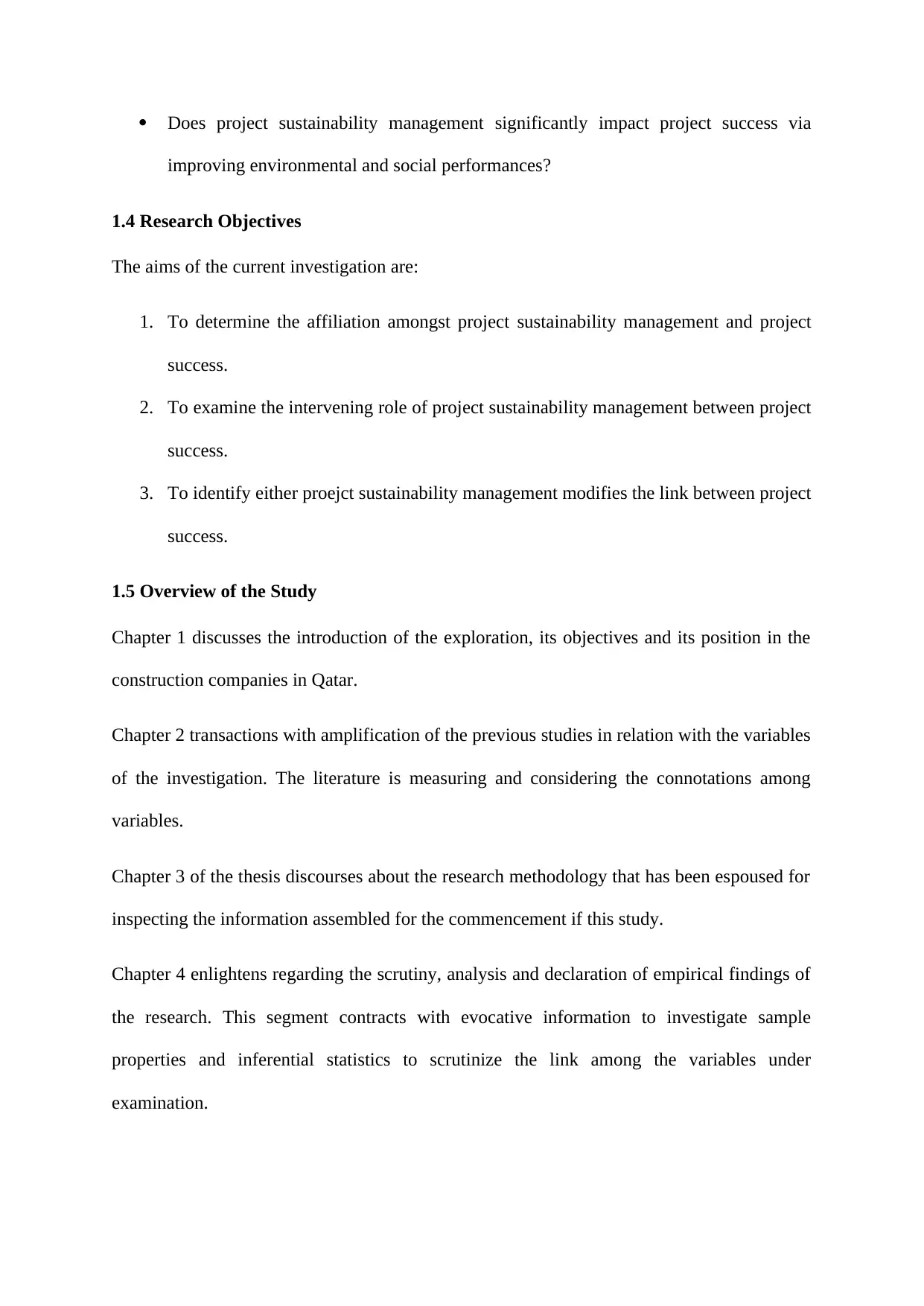
Does project sustainability management significantly impact project success via
improving environmental and social performances?
1.4 Research Objectives
The aims of the current investigation are:
1. To determine the affiliation amongst project sustainability management and project
success.
2. To examine the intervening role of project sustainability management between project
success.
3. To identify either proejct sustainability management modifies the link between project
success.
1.5 Overview of the Study
Chapter 1 discusses the introduction of the exploration, its objectives and its position in the
construction companies in Qatar.
Chapter 2 transactions with amplification of the previous studies in relation with the variables
of the investigation. The literature is measuring and considering the connotations among
variables.
Chapter 3 of the thesis discourses about the research methodology that has been espoused for
inspecting the information assembled for the commencement if this study.
Chapter 4 enlightens regarding the scrutiny, analysis and declaration of empirical findings of
the research. This segment contracts with evocative information to investigate sample
properties and inferential statistics to scrutinize the link among the variables under
examination.
improving environmental and social performances?
1.4 Research Objectives
The aims of the current investigation are:
1. To determine the affiliation amongst project sustainability management and project
success.
2. To examine the intervening role of project sustainability management between project
success.
3. To identify either proejct sustainability management modifies the link between project
success.
1.5 Overview of the Study
Chapter 1 discusses the introduction of the exploration, its objectives and its position in the
construction companies in Qatar.
Chapter 2 transactions with amplification of the previous studies in relation with the variables
of the investigation. The literature is measuring and considering the connotations among
variables.
Chapter 3 of the thesis discourses about the research methodology that has been espoused for
inspecting the information assembled for the commencement if this study.
Chapter 4 enlightens regarding the scrutiny, analysis and declaration of empirical findings of
the research. This segment contracts with evocative information to investigate sample
properties and inferential statistics to scrutinize the link among the variables under
examination.
Paraphrase This Document
Need a fresh take? Get an instant paraphrase of this document with our AI Paraphraser
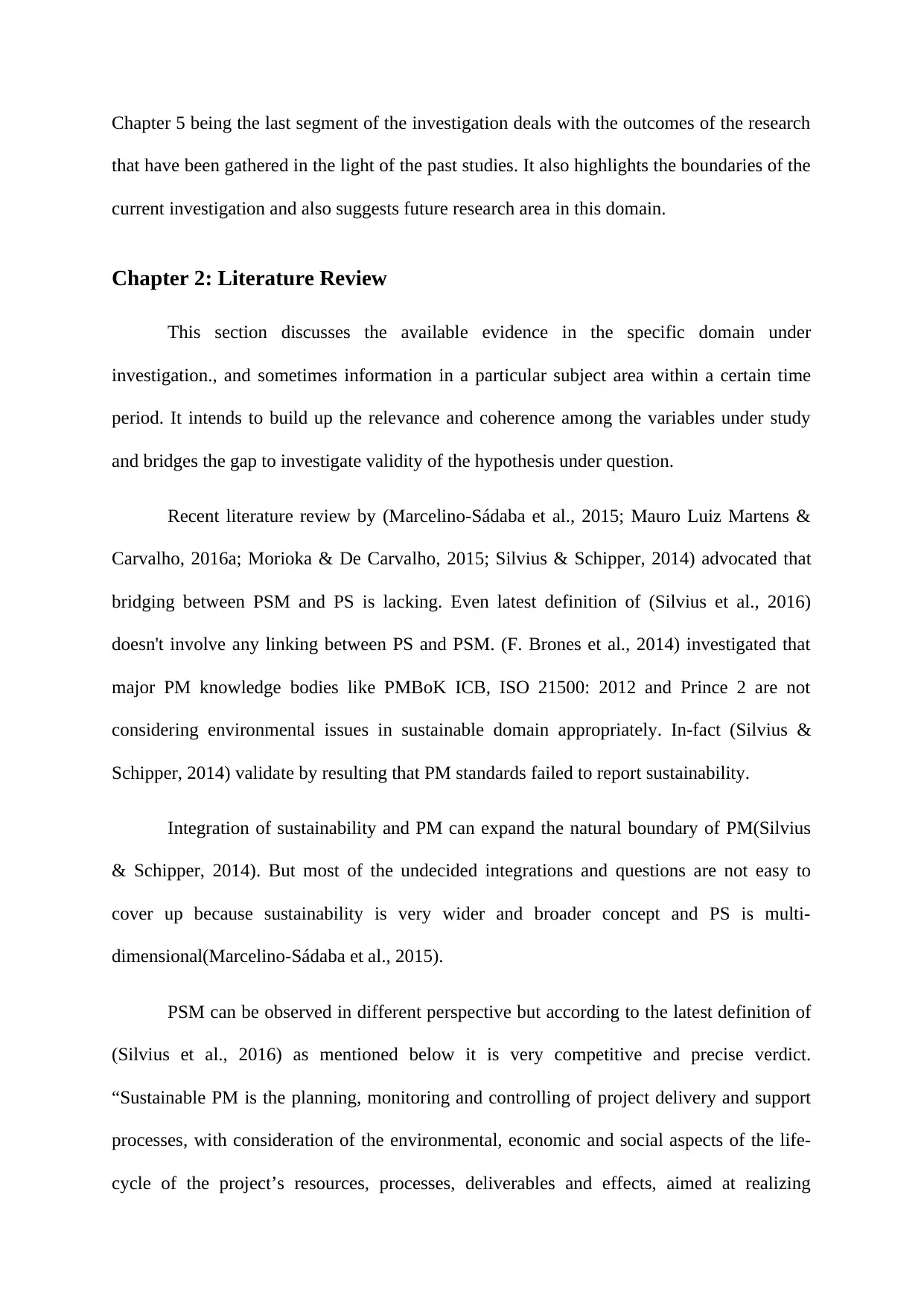
Chapter 5 being the last segment of the investigation deals with the outcomes of the research
that have been gathered in the light of the past studies. It also highlights the boundaries of the
current investigation and also suggests future research area in this domain.
Chapter 2: Literature Review
This section discusses the available evidence in the specific domain under
investigation., and sometimes information in a particular subject area within a certain time
period. It intends to build up the relevance and coherence among the variables under study
and bridges the gap to investigate validity of the hypothesis under question.
Recent literature review by (Marcelino-Sádaba et al., 2015; Mauro Luiz Martens &
Carvalho, 2016a; Morioka & De Carvalho, 2015; Silvius & Schipper, 2014) advocated that
bridging between PSM and PS is lacking. Even latest definition of (Silvius et al., 2016)
doesn't involve any linking between PS and PSM. (F. Brones et al., 2014) investigated that
major PM knowledge bodies like PMBoK ICB, ISO 21500: 2012 and Prince 2 are not
considering environmental issues in sustainable domain appropriately. In-fact (Silvius &
Schipper, 2014) validate by resulting that PM standards failed to report sustainability.
Integration of sustainability and PM can expand the natural boundary of PM(Silvius
& Schipper, 2014). But most of the undecided integrations and questions are not easy to
cover up because sustainability is very wider and broader concept and PS is multi-
dimensional(Marcelino-Sádaba et al., 2015).
PSM can be observed in different perspective but according to the latest definition of
(Silvius et al., 2016) as mentioned below it is very competitive and precise verdict.
“Sustainable PM is the planning, monitoring and controlling of project delivery and support
processes, with consideration of the environmental, economic and social aspects of the life-
cycle of the project’s resources, processes, deliverables and effects, aimed at realizing
that have been gathered in the light of the past studies. It also highlights the boundaries of the
current investigation and also suggests future research area in this domain.
Chapter 2: Literature Review
This section discusses the available evidence in the specific domain under
investigation., and sometimes information in a particular subject area within a certain time
period. It intends to build up the relevance and coherence among the variables under study
and bridges the gap to investigate validity of the hypothesis under question.
Recent literature review by (Marcelino-Sádaba et al., 2015; Mauro Luiz Martens &
Carvalho, 2016a; Morioka & De Carvalho, 2015; Silvius & Schipper, 2014) advocated that
bridging between PSM and PS is lacking. Even latest definition of (Silvius et al., 2016)
doesn't involve any linking between PS and PSM. (F. Brones et al., 2014) investigated that
major PM knowledge bodies like PMBoK ICB, ISO 21500: 2012 and Prince 2 are not
considering environmental issues in sustainable domain appropriately. In-fact (Silvius &
Schipper, 2014) validate by resulting that PM standards failed to report sustainability.
Integration of sustainability and PM can expand the natural boundary of PM(Silvius
& Schipper, 2014). But most of the undecided integrations and questions are not easy to
cover up because sustainability is very wider and broader concept and PS is multi-
dimensional(Marcelino-Sádaba et al., 2015).
PSM can be observed in different perspective but according to the latest definition of
(Silvius et al., 2016) as mentioned below it is very competitive and precise verdict.
“Sustainable PM is the planning, monitoring and controlling of project delivery and support
processes, with consideration of the environmental, economic and social aspects of the life-
cycle of the project’s resources, processes, deliverables and effects, aimed at realizing
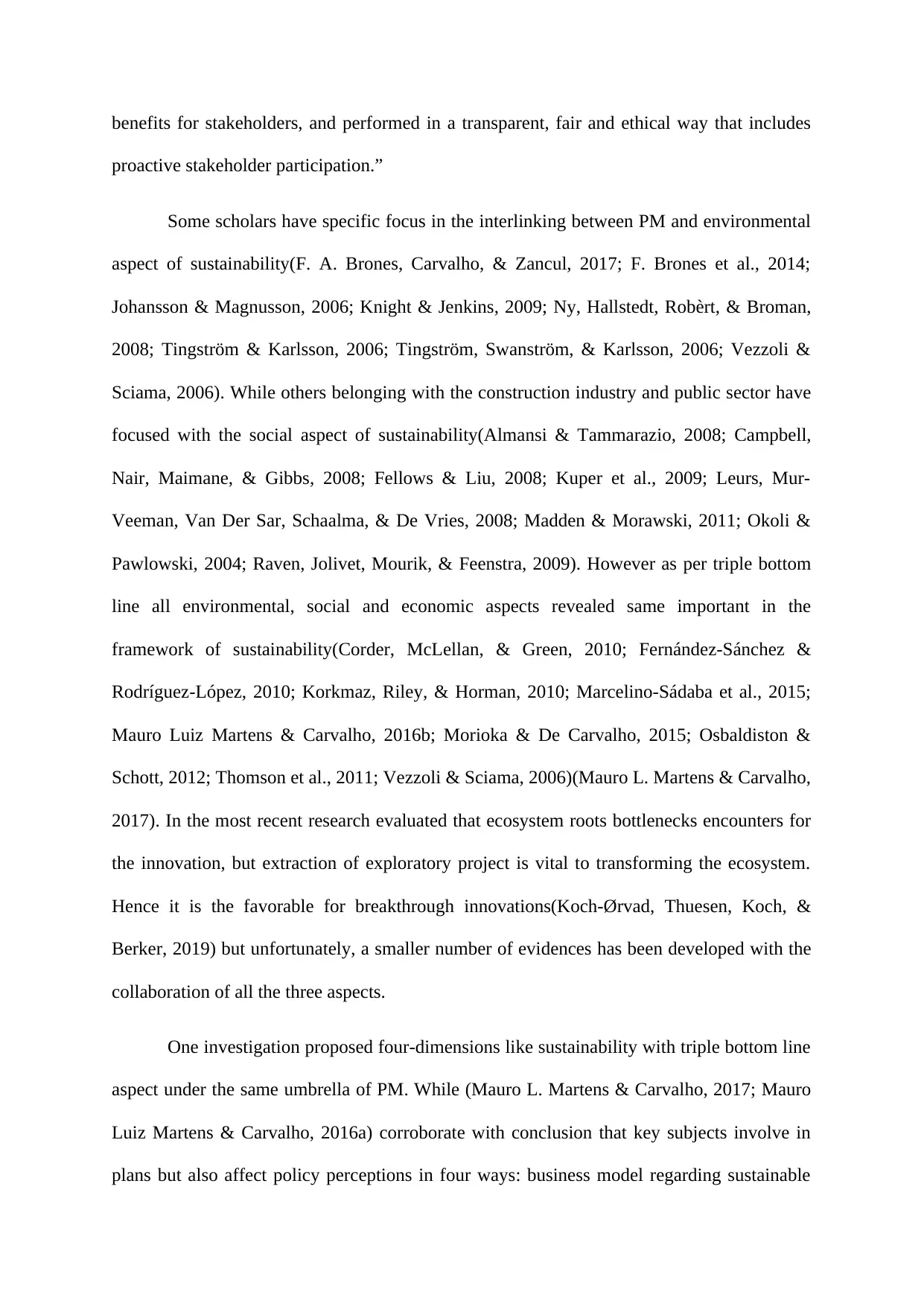
benefits for stakeholders, and performed in a transparent, fair and ethical way that includes
proactive stakeholder participation.”
Some scholars have specific focus in the interlinking between PM and environmental
aspect of sustainability(F. A. Brones, Carvalho, & Zancul, 2017; F. Brones et al., 2014;
Johansson & Magnusson, 2006; Knight & Jenkins, 2009; Ny, Hallstedt, Robèrt, & Broman,
2008; Tingström & Karlsson, 2006; Tingström, Swanström, & Karlsson, 2006; Vezzoli &
Sciama, 2006). While others belonging with the construction industry and public sector have
focused with the social aspect of sustainability(Almansi & Tammarazio, 2008; Campbell,
Nair, Maimane, & Gibbs, 2008; Fellows & Liu, 2008; Kuper et al., 2009; Leurs, Mur-
Veeman, Van Der Sar, Schaalma, & De Vries, 2008; Madden & Morawski, 2011; Okoli &
Pawlowski, 2004; Raven, Jolivet, Mourik, & Feenstra, 2009). However as per triple bottom
line all environmental, social and economic aspects revealed same important in the
framework of sustainability(Corder, McLellan, & Green, 2010; Fernández-Sánchez &
Rodríguez-López, 2010; Korkmaz, Riley, & Horman, 2010; Marcelino-Sádaba et al., 2015;
Mauro Luiz Martens & Carvalho, 2016b; Morioka & De Carvalho, 2015; Osbaldiston &
Schott, 2012; Thomson et al., 2011; Vezzoli & Sciama, 2006)(Mauro L. Martens & Carvalho,
2017). In the most recent research evaluated that ecosystem roots bottlenecks encounters for
the innovation, but extraction of exploratory project is vital to transforming the ecosystem.
Hence it is the favorable for breakthrough innovations(Koch-Ørvad, Thuesen, Koch, &
Berker, 2019) but unfortunately, a smaller number of evidences has been developed with the
collaboration of all the three aspects.
One investigation proposed four-dimensions like sustainability with triple bottom line
aspect under the same umbrella of PM. While (Mauro L. Martens & Carvalho, 2017; Mauro
Luiz Martens & Carvalho, 2016a) corroborate with conclusion that key subjects involve in
plans but also affect policy perceptions in four ways: business model regarding sustainable
proactive stakeholder participation.”
Some scholars have specific focus in the interlinking between PM and environmental
aspect of sustainability(F. A. Brones, Carvalho, & Zancul, 2017; F. Brones et al., 2014;
Johansson & Magnusson, 2006; Knight & Jenkins, 2009; Ny, Hallstedt, Robèrt, & Broman,
2008; Tingström & Karlsson, 2006; Tingström, Swanström, & Karlsson, 2006; Vezzoli &
Sciama, 2006). While others belonging with the construction industry and public sector have
focused with the social aspect of sustainability(Almansi & Tammarazio, 2008; Campbell,
Nair, Maimane, & Gibbs, 2008; Fellows & Liu, 2008; Kuper et al., 2009; Leurs, Mur-
Veeman, Van Der Sar, Schaalma, & De Vries, 2008; Madden & Morawski, 2011; Okoli &
Pawlowski, 2004; Raven, Jolivet, Mourik, & Feenstra, 2009). However as per triple bottom
line all environmental, social and economic aspects revealed same important in the
framework of sustainability(Corder, McLellan, & Green, 2010; Fernández-Sánchez &
Rodríguez-López, 2010; Korkmaz, Riley, & Horman, 2010; Marcelino-Sádaba et al., 2015;
Mauro Luiz Martens & Carvalho, 2016b; Morioka & De Carvalho, 2015; Osbaldiston &
Schott, 2012; Thomson et al., 2011; Vezzoli & Sciama, 2006)(Mauro L. Martens & Carvalho,
2017). In the most recent research evaluated that ecosystem roots bottlenecks encounters for
the innovation, but extraction of exploratory project is vital to transforming the ecosystem.
Hence it is the favorable for breakthrough innovations(Koch-Ørvad, Thuesen, Koch, &
Berker, 2019) but unfortunately, a smaller number of evidences has been developed with the
collaboration of all the three aspects.
One investigation proposed four-dimensions like sustainability with triple bottom line
aspect under the same umbrella of PM. While (Mauro L. Martens & Carvalho, 2017; Mauro
Luiz Martens & Carvalho, 2016a) corroborate with conclusion that key subjects involve in
plans but also affect policy perceptions in four ways: business model regarding sustainable
⊘ This is a preview!⊘
Do you want full access?
Subscribe today to unlock all pages.

Trusted by 1+ million students worldwide
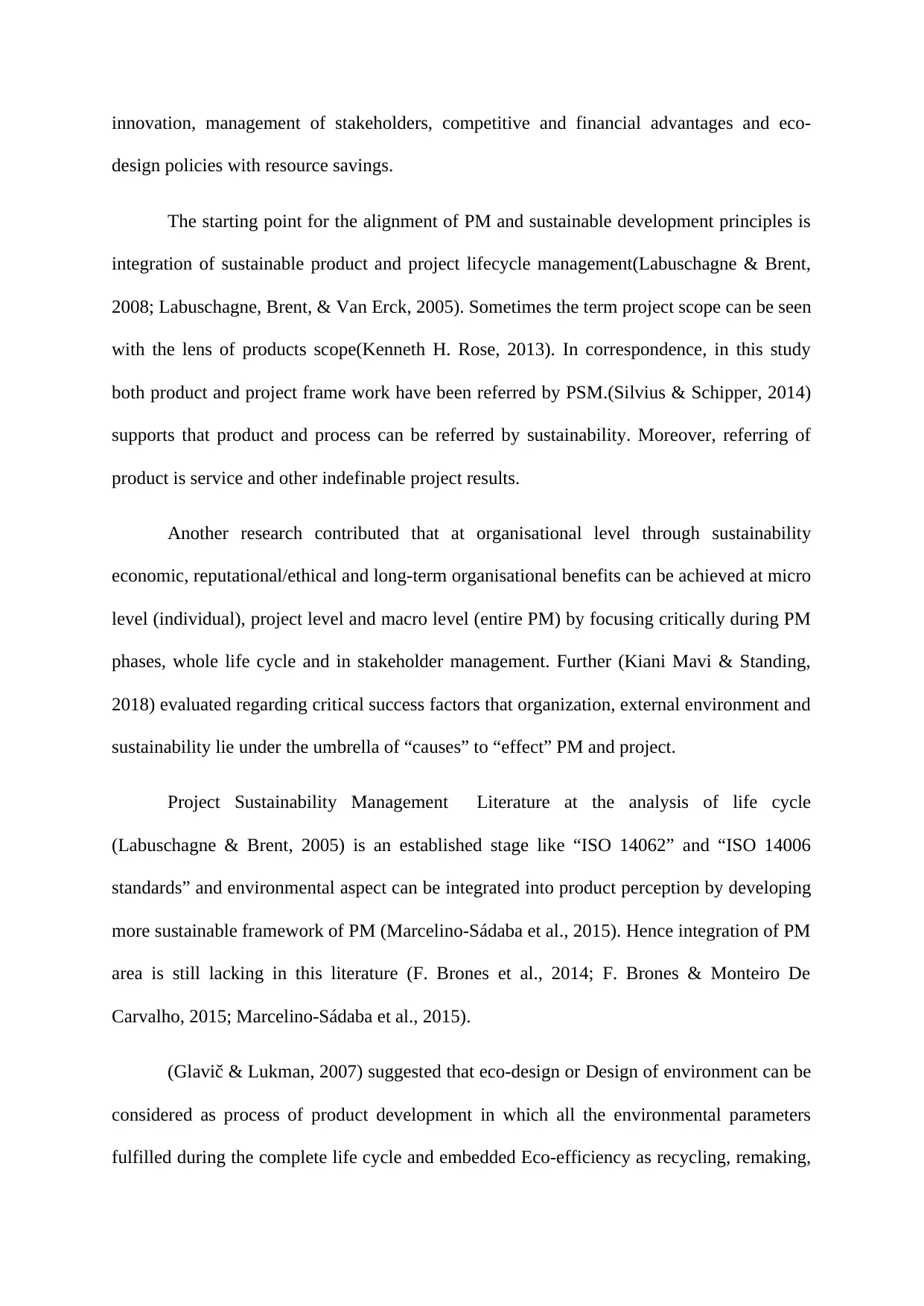
innovation, management of stakeholders, competitive and financial advantages and eco-
design policies with resource savings.
The starting point for the alignment of PM and sustainable development principles is
integration of sustainable product and project lifecycle management(Labuschagne & Brent,
2008; Labuschagne, Brent, & Van Erck, 2005). Sometimes the term project scope can be seen
with the lens of products scope(Kenneth H. Rose, 2013). In correspondence, in this study
both product and project frame work have been referred by PSM.(Silvius & Schipper, 2014)
supports that product and process can be referred by sustainability. Moreover, referring of
product is service and other indefinable project results.
Another research contributed that at organisational level through sustainability
economic, reputational/ethical and long-term organisational benefits can be achieved at micro
level (individual), project level and macro level (entire PM) by focusing critically during PM
phases, whole life cycle and in stakeholder management. Further (Kiani Mavi & Standing,
2018) evaluated regarding critical success factors that organization, external environment and
sustainability lie under the umbrella of “causes” to “effect” PM and project.
Project Sustainability Management Literature at the analysis of life cycle
(Labuschagne & Brent, 2005) is an established stage like “ISO 14062” and “ISO 14006
standards” and environmental aspect can be integrated into product perception by developing
more sustainable framework of PM (Marcelino-Sádaba et al., 2015). Hence integration of PM
area is still lacking in this literature (F. Brones et al., 2014; F. Brones & Monteiro De
Carvalho, 2015; Marcelino-Sádaba et al., 2015).
(Glavič & Lukman, 2007) suggested that eco-design or Design of environment can be
considered as process of product development in which all the environmental parameters
fulfilled during the complete life cycle and embedded Eco-efficiency as recycling, remaking,
design policies with resource savings.
The starting point for the alignment of PM and sustainable development principles is
integration of sustainable product and project lifecycle management(Labuschagne & Brent,
2008; Labuschagne, Brent, & Van Erck, 2005). Sometimes the term project scope can be seen
with the lens of products scope(Kenneth H. Rose, 2013). In correspondence, in this study
both product and project frame work have been referred by PSM.(Silvius & Schipper, 2014)
supports that product and process can be referred by sustainability. Moreover, referring of
product is service and other indefinable project results.
Another research contributed that at organisational level through sustainability
economic, reputational/ethical and long-term organisational benefits can be achieved at micro
level (individual), project level and macro level (entire PM) by focusing critically during PM
phases, whole life cycle and in stakeholder management. Further (Kiani Mavi & Standing,
2018) evaluated regarding critical success factors that organization, external environment and
sustainability lie under the umbrella of “causes” to “effect” PM and project.
Project Sustainability Management Literature at the analysis of life cycle
(Labuschagne & Brent, 2005) is an established stage like “ISO 14062” and “ISO 14006
standards” and environmental aspect can be integrated into product perception by developing
more sustainable framework of PM (Marcelino-Sádaba et al., 2015). Hence integration of PM
area is still lacking in this literature (F. Brones et al., 2014; F. Brones & Monteiro De
Carvalho, 2015; Marcelino-Sádaba et al., 2015).
(Glavič & Lukman, 2007) suggested that eco-design or Design of environment can be
considered as process of product development in which all the environmental parameters
fulfilled during the complete life cycle and embedded Eco-efficiency as recycling, remaking,
Paraphrase This Document
Need a fresh take? Get an instant paraphrase of this document with our AI Paraphraser
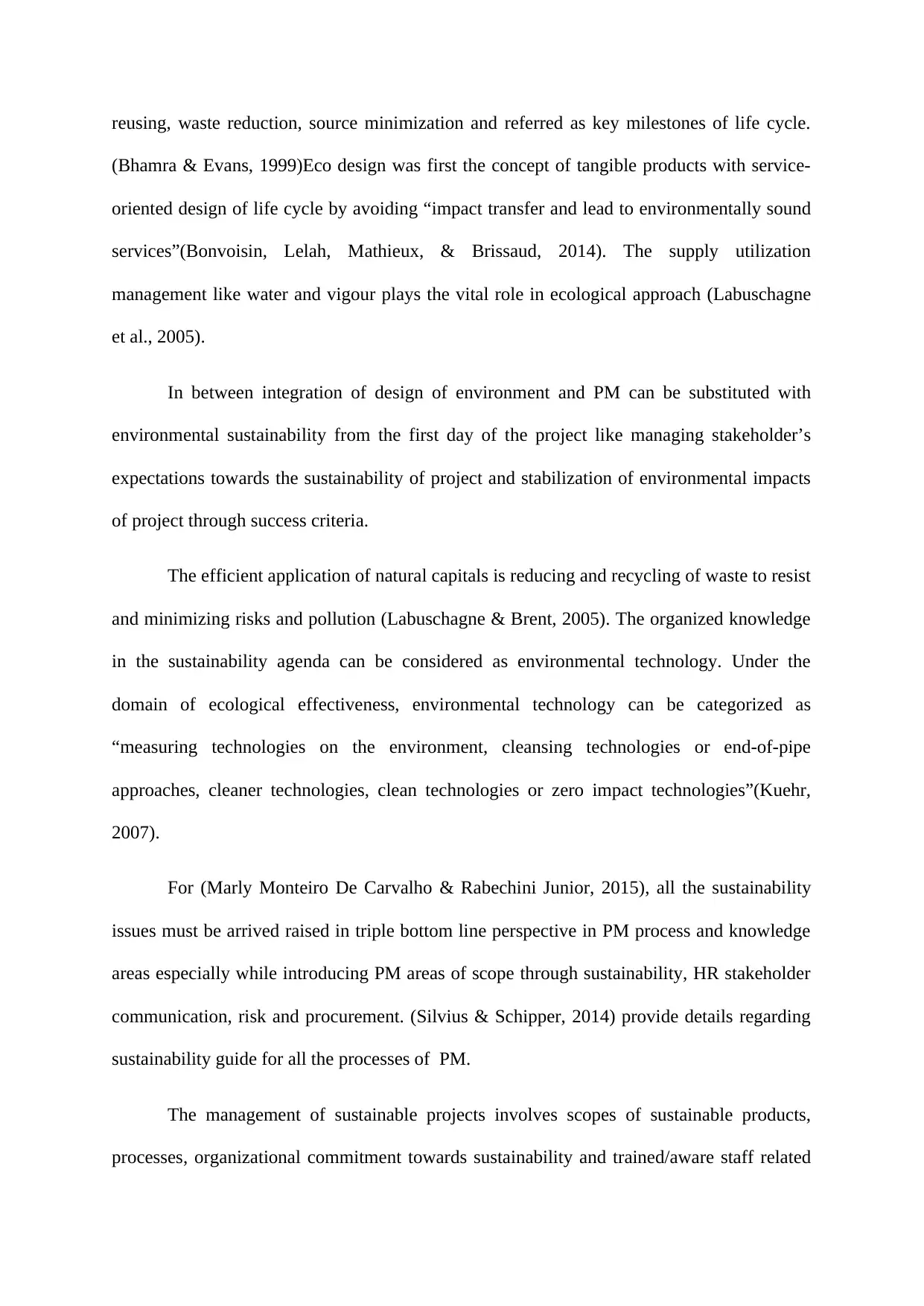
reusing, waste reduction, source minimization and referred as key milestones of life cycle.
(Bhamra & Evans, 1999)Eco design was first the concept of tangible products with service-
oriented design of life cycle by avoiding “impact transfer and lead to environmentally sound
services”(Bonvoisin, Lelah, Mathieux, & Brissaud, 2014). The supply utilization
management like water and vigour plays the vital role in ecological approach (Labuschagne
et al., 2005).
In between integration of design of environment and PM can be substituted with
environmental sustainability from the first day of the project like managing stakeholder’s
expectations towards the sustainability of project and stabilization of environmental impacts
of project through success criteria.
The efficient application of natural capitals is reducing and recycling of waste to resist
and minimizing risks and pollution (Labuschagne & Brent, 2005). The organized knowledge
in the sustainability agenda can be considered as environmental technology. Under the
domain of ecological effectiveness, environmental technology can be categorized as
“measuring technologies on the environment, cleansing technologies or end-of-pipe
approaches, cleaner technologies, clean technologies or zero impact technologies”(Kuehr,
2007).
For (Marly Monteiro De Carvalho & Rabechini Junior, 2015), all the sustainability
issues must be arrived raised in triple bottom line perspective in PM process and knowledge
areas especially while introducing PM areas of scope through sustainability, HR stakeholder
communication, risk and procurement. (Silvius & Schipper, 2014) provide details regarding
sustainability guide for all the processes of PM.
The management of sustainable projects involves scopes of sustainable products,
processes, organizational commitment towards sustainability and trained/aware staff related
(Bhamra & Evans, 1999)Eco design was first the concept of tangible products with service-
oriented design of life cycle by avoiding “impact transfer and lead to environmentally sound
services”(Bonvoisin, Lelah, Mathieux, & Brissaud, 2014). The supply utilization
management like water and vigour plays the vital role in ecological approach (Labuschagne
et al., 2005).
In between integration of design of environment and PM can be substituted with
environmental sustainability from the first day of the project like managing stakeholder’s
expectations towards the sustainability of project and stabilization of environmental impacts
of project through success criteria.
The efficient application of natural capitals is reducing and recycling of waste to resist
and minimizing risks and pollution (Labuschagne & Brent, 2005). The organized knowledge
in the sustainability agenda can be considered as environmental technology. Under the
domain of ecological effectiveness, environmental technology can be categorized as
“measuring technologies on the environment, cleansing technologies or end-of-pipe
approaches, cleaner technologies, clean technologies or zero impact technologies”(Kuehr,
2007).
For (Marly Monteiro De Carvalho & Rabechini Junior, 2015), all the sustainability
issues must be arrived raised in triple bottom line perspective in PM process and knowledge
areas especially while introducing PM areas of scope through sustainability, HR stakeholder
communication, risk and procurement. (Silvius & Schipper, 2014) provide details regarding
sustainability guide for all the processes of PM.
The management of sustainable projects involves scopes of sustainable products,
processes, organizational commitment towards sustainability and trained/aware staff related
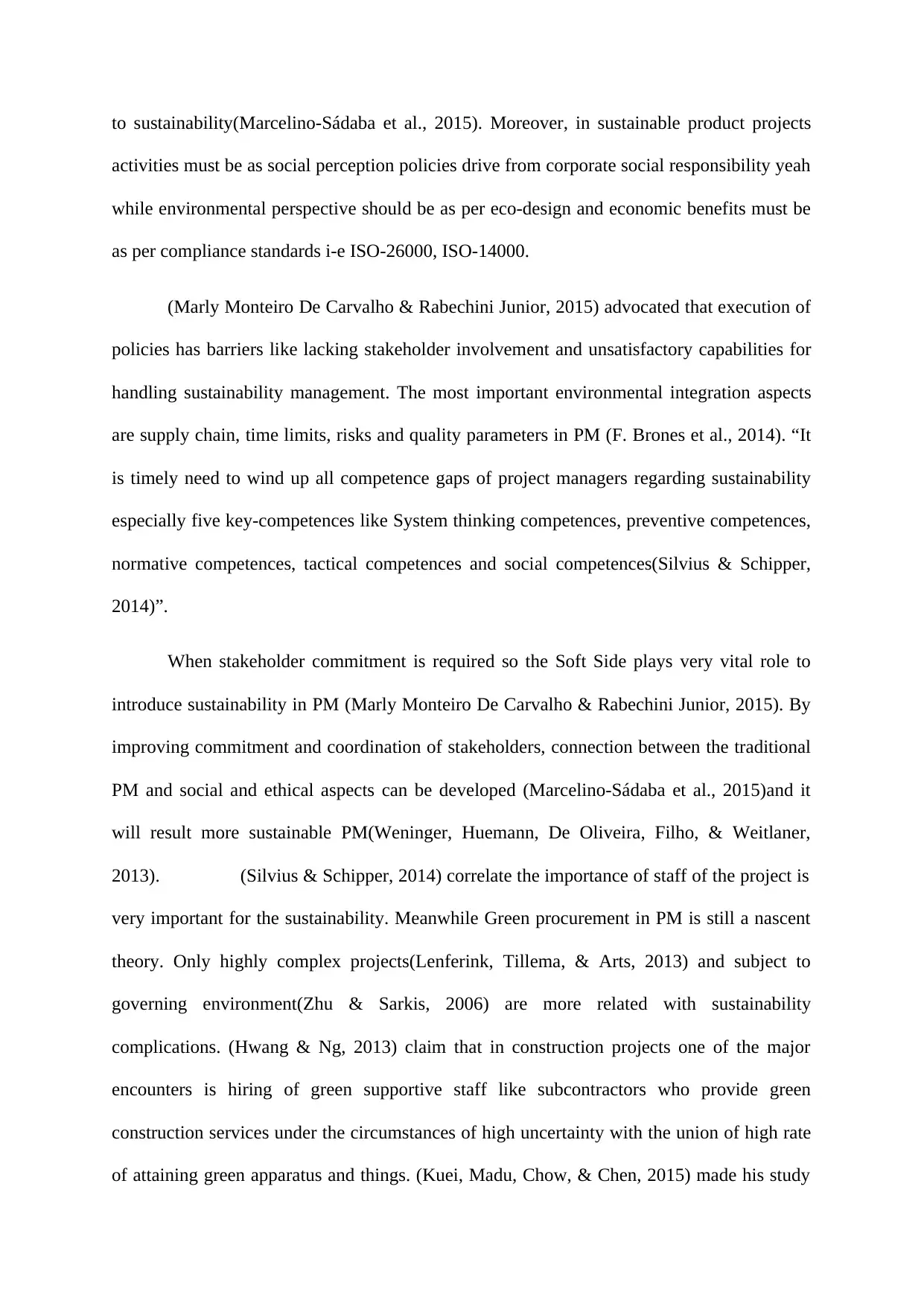
to sustainability(Marcelino-Sádaba et al., 2015). Moreover, in sustainable product projects
activities must be as social perception policies drive from corporate social responsibility yeah
while environmental perspective should be as per eco-design and economic benefits must be
as per compliance standards i-e ISO-26000, ISO-14000.
(Marly Monteiro De Carvalho & Rabechini Junior, 2015) advocated that execution of
policies has barriers like lacking stakeholder involvement and unsatisfactory capabilities for
handling sustainability management. The most important environmental integration aspects
are supply chain, time limits, risks and quality parameters in PM (F. Brones et al., 2014). “It
is timely need to wind up all competence gaps of project managers regarding sustainability
especially five key-competences like System thinking competences, preventive competences,
normative competences, tactical competences and social competences(Silvius & Schipper,
2014)”.
When stakeholder commitment is required so the Soft Side plays very vital role to
introduce sustainability in PM (Marly Monteiro De Carvalho & Rabechini Junior, 2015). By
improving commitment and coordination of stakeholders, connection between the traditional
PM and social and ethical aspects can be developed (Marcelino-Sádaba et al., 2015)and it
will result more sustainable PM(Weninger, Huemann, De Oliveira, Filho, & Weitlaner,
2013). (Silvius & Schipper, 2014) correlate the importance of staff of the project is
very important for the sustainability. Meanwhile Green procurement in PM is still a nascent
theory. Only highly complex projects(Lenferink, Tillema, & Arts, 2013) and subject to
governing environment(Zhu & Sarkis, 2006) are more related with sustainability
complications. (Hwang & Ng, 2013) claim that in construction projects one of the major
encounters is hiring of green supportive staff like subcontractors who provide green
construction services under the circumstances of high uncertainty with the union of high rate
of attaining green apparatus and things. (Kuei, Madu, Chow, & Chen, 2015) made his study
activities must be as social perception policies drive from corporate social responsibility yeah
while environmental perspective should be as per eco-design and economic benefits must be
as per compliance standards i-e ISO-26000, ISO-14000.
(Marly Monteiro De Carvalho & Rabechini Junior, 2015) advocated that execution of
policies has barriers like lacking stakeholder involvement and unsatisfactory capabilities for
handling sustainability management. The most important environmental integration aspects
are supply chain, time limits, risks and quality parameters in PM (F. Brones et al., 2014). “It
is timely need to wind up all competence gaps of project managers regarding sustainability
especially five key-competences like System thinking competences, preventive competences,
normative competences, tactical competences and social competences(Silvius & Schipper,
2014)”.
When stakeholder commitment is required so the Soft Side plays very vital role to
introduce sustainability in PM (Marly Monteiro De Carvalho & Rabechini Junior, 2015). By
improving commitment and coordination of stakeholders, connection between the traditional
PM and social and ethical aspects can be developed (Marcelino-Sádaba et al., 2015)and it
will result more sustainable PM(Weninger, Huemann, De Oliveira, Filho, & Weitlaner,
2013). (Silvius & Schipper, 2014) correlate the importance of staff of the project is
very important for the sustainability. Meanwhile Green procurement in PM is still a nascent
theory. Only highly complex projects(Lenferink, Tillema, & Arts, 2013) and subject to
governing environment(Zhu & Sarkis, 2006) are more related with sustainability
complications. (Hwang & Ng, 2013) claim that in construction projects one of the major
encounters is hiring of green supportive staff like subcontractors who provide green
construction services under the circumstances of high uncertainty with the union of high rate
of attaining green apparatus and things. (Kuei, Madu, Chow, & Chen, 2015) made his study
⊘ This is a preview!⊘
Do you want full access?
Subscribe today to unlock all pages.

Trusted by 1+ million students worldwide
1 out of 21
Your All-in-One AI-Powered Toolkit for Academic Success.
+13062052269
info@desklib.com
Available 24*7 on WhatsApp / Email
![[object Object]](/_next/static/media/star-bottom.7253800d.svg)
Unlock your academic potential
Copyright © 2020–2025 A2Z Services. All Rights Reserved. Developed and managed by ZUCOL.